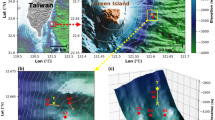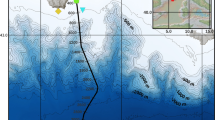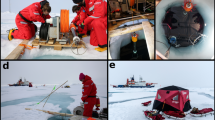Abstract
Mixing in the ocean thermocline is thought to occur in part by random superposition of internal waves, leading to occasional episodes of shear instability1. Statistical models of the resulting mixing have been formulated2,3 which are roughly consistent with the few available direct estimates of average mixing rates4–6. However, clear evidence of the direct association between individual mixing patches and wave instability has been lacking7. Here we report the use of a new fine- and microstructure profiler during the Frontal Air–Sea Interaction Experiment (FASINEX)8 to investigate mixing processes in the sub-tropical front of the north-west Atlantic in great detail. The novel combination of fine-scale and microstructure sensors on one vehicle provided sufficient resol-ution to reveal quantitative evidence of shear instability in the thermocline. The strongest sub-surface mixing was found in association with small-vertical-scale internal waves that may have been influenced by the velocity and density structure of the front.
This is a preview of subscription content, access via your institution
Access options
Subscribe to this journal
Receive 51 print issues and online access
$199.00 per year
only $3.90 per issue
Buy this article
- Purchase on Springer Link
- Instant access to full article PDF
Prices may be subject to local taxes which are calculated during checkout
Similar content being viewed by others
References
1. Garrett, C. J. R. & Munk, W. H. Deep Sea Res. 19, 823–832 (1972). 2. Gargett, A. E. & Holloway, G. /. mar. Res. 42, 15–27 (1984). 3. Desaubies, Y. & Smith, W. K. /. phys. Oceanogr. 12, 1245–1259 (1982). 4. Gargett, A. E. /. mar. Res. 42, 359–393 (1984). 5. Mourn, J. N. & Osborn, T. R. /. phys. Oceanogr. 16, 1250–1258 (1986). 6. Gregg, M. C. in Internal Gravity Waves and Small–Scale Turbulence: Proc. (eds Muller, P. & Pujalet, R.) 1–24 (Hawaii Institute of Geophysics, Honolulu 1984). 7. Gregg, M. C., D'Asaro, E. A., Shay,, T. J. & Larson, N. /. phys. Oceanogr. 16,856–885 (1986). 8. Stage, S. A. & Weller, R. A. Bull. Am. met. Soc. 66, 1522–1520 (1985). 9. Hayes, S. P., Milburn, H. B. & Ford, E. F. /. atmos. ocean. Technol. 1, 220–236 (1984). 10. Osborn, T. R. J. phys. Oceanogr. 4, 109–115 (1974). 11. Pollard, R. Nature 323, 433–434 (1986). 12. Leaman, K. D. & Sanford, T. B. /. geophys. Res. 15, 1975–1978 (1975). 13. Osborn, T. R. & Cox, C. S. Geophys. Fluid Dyn. 3, 321–345 (1972). 14. Miles. J. W. .7. Fluid Dyn. 10, 496–508 (1961). 15. Rohr, J. J., Helland, K. N., Itsweire, E. C. & Van Atta, C. W. in 5th Int. Symp. on Turbulent Shear Flows, Cornell Univesity, Ithaca, New York, August 7–9, 1985 (ed. Lumley, J. L.) 21–1–22–6 (Pennsylvania State University, 1985). 16. See Oakey, N. S. J. phys. Oceanogr. 12, 256–271 (1982). 17. Garrett, C. J. R. & Munk, W. H. Geophys. Fluid Dyn. 2, 225–264 (1972). 18. Booker, J. R. & Bretherton, F. P. /. Fluid Mech. 27, 513–539 (1967). 19. Kunze, E. & Sanford, T. B. /. phys. Oceanogr. 14, 566–581 (1984).
Author information
Authors and Affiliations
Rights and permissions
About this article
Cite this article
Toole, J., Schmitt, R. Small-scale structures in the north-west Atlantic sub-tropical front. Nature 327, 47–49 (1987). https://doi.org/10.1038/327047a0
Received:
Accepted:
Issue Date:
DOI: https://doi.org/10.1038/327047a0
Comments
By submitting a comment you agree to abide by our Terms and Community Guidelines. If you find something abusive or that does not comply with our terms or guidelines please flag it as inappropriate.



